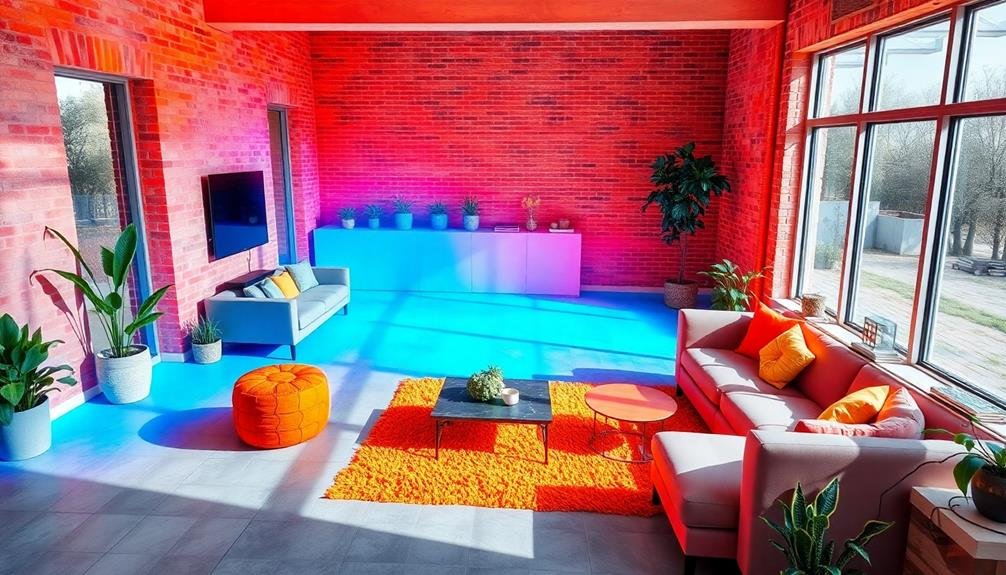The top three thermal mass flooring choices for temperature control are concrete, tile/stone, and brick. Concrete offers exceptional heat retention due to its high density and specific heat capacity. Tile and stone options, including ceramic, porcelain, and natural stones, absorb heat slowly and release it gradually. Brick floors regulate indoor temperatures effectively while providing unique aesthetics. All three materials work best with direct sunlight or radiant heating systems, helping to reduce your heating and cooling costs. Each option has its own benefits and considerations, from various finishes to installation requirements. Exploring these choices in-depth will help you make the best decision for your home's climate control needs.
Concrete Flooring

Concrete, the workhorse of thermal mass flooring, offers exceptional heat retention properties. You'll find it's a top choice for maintaining stable indoor temperatures due to its high density and specific heat capacity.
As a thermal mass material, concrete absorbs heat during warm periods and releases it slowly when the surrounding air cools.
In residential settings, you can use concrete flooring in various ways. Polished concrete provides a sleek, modern look while exposed aggregate offers a more textured appearance. You can even stamp or stain concrete to mimic other materials like stone or wood.
Concrete's thermal mass benefits are most effective when exposed to direct sunlight or radiant heating systems. It works well with passive solar design, absorbing heat during the day and radiating it at night. This can greatly reduce your heating and cooling costs.
While concrete excels in heat retention, it can feel cold underfoot. You can address this by incorporating in-floor heating systems or using area rugs strategically.
Remember that concrete's effectiveness as thermal mass depends on its thickness, with 4 inches being the minimum recommended for ideal performance.
Tile and Stone Options
Tile and stone's versatility makes them excellent choices for thermal mass flooring. These materials absorb heat slowly during the day and release it gradually at night, helping to maintain consistent indoor temperatures.
You'll find a wide range of options, from ceramic and porcelain tiles to natural stones like slate, marble, and granite.
Ceramic and porcelain tiles are popular due to their durability and cost-effectiveness. They come in various colors and patterns, allowing you to match your interior design preferences.
Natural stones offer unique aesthetics and superior thermal properties, but they're often more expensive and require more maintenance.
When selecting tile or stone for thermal mass flooring, consider the material's thickness and density. Thicker, denser materials generally provide better thermal performance.
Dark-colored options absorb more heat, while lighter colors reflect it.
For ideal thermal mass performance, install your tile or stone flooring in areas that receive direct sunlight during winter months.
Combine these materials with proper insulation and ventilation to maximize their temperature-regulating benefits.
You can also enhance their effectiveness by using radiant floor heating systems underneath, creating a highly efficient and comfortable living space.
Brick Floors

For centuries, brick floors have been prized for their durability and thermal mass properties. They're an excellent choice for thermal mass flooring, as they absorb heat during the day and release it slowly at night, helping to regulate indoor temperatures.
You'll find that brick floors come in various colors, patterns, and textures, allowing you to achieve a unique look while benefiting from their thermal properties. They're particularly well-suited for areas with direct sunlight or radiant heating systems.
When considering brick floors, keep in mind that they can be more challenging to install than other flooring options. You'll need to guarantee a sturdy subfloor and proper sealing to prevent moisture issues.
Brick floors can also be rough on bare feet, so you might want to use area rugs in high-traffic zones.
Maintenance is relatively simple, requiring regular sweeping and occasional mopping. However, you'll need to reseal the bricks periodically to maintain their appearance and protect them from stains.
Frequently Asked Questions
How Does Thermal Mass Flooring Affect Indoor Air Quality?
Thermal mass flooring can improve your indoor air quality. It regulates humidity levels, reducing mold growth and dust mites. It also minimizes air circulation, which lowers the spread of airborne pollutants and allergens in your home.
Can Thermal Mass Flooring Be Installed Over Existing Floors?
Yes, you can install thermal mass flooring over existing floors. You'll need to evaluate the structural load capacity and height limitations. It's often easier to add a thin layer of concrete or tile rather than thick stone slabs.
What Maintenance Is Required for Thermal Mass Flooring?
You'll need to regularly sweep and mop your thermal mass flooring. Seal concrete or stone floors annually. Polish wood floors every few years. Fix any cracks promptly. Avoid harsh chemicals and maintain consistent indoor humidity for best results.
How Does Thermal Mass Flooring Impact Home Insurance Rates?
You'll likely see minimal impact on home insurance rates with thermal mass flooring. It's generally considered a safe, durable option. However, you should inform your insurer about any significant home improvements to guarantee proper coverage.
Are There Any Health Concerns Associated With Thermal Mass Flooring Materials?
You shouldn't worry much about health issues with thermal mass flooring. Most materials are safe, but be cautious of radon from concrete and VOCs from some sealants. Proper installation and ventilation will minimize any potential risks.
In Summary
You've explored three excellent thermal mass flooring options for temperature control. Whether you choose concrete, tile and stone, or brick, you'll benefit from improved energy efficiency and comfortable indoor temperatures. Remember, the effectiveness of your thermal mass floor depends on proper installation and integration with your home's overall design. Consider your specific needs, climate, and budget when making your decision. With the right choice, you'll enjoy a more stable and comfortable living environment year-round.





Leave a Reply